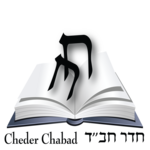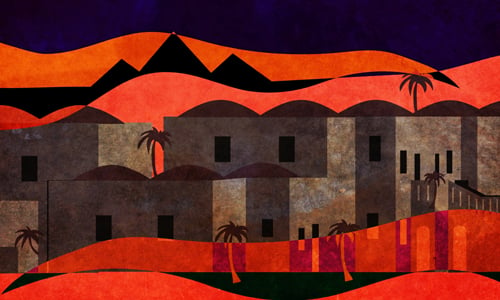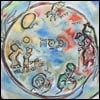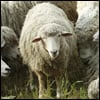At Midnight G‑d's Love For Us Is Revealed
When Moses told Pharaoh G‑d's message about the impending plague of the death of the first born, he changed the words of G‑d. G‑d said that the plague would take place "at midnight,"1 meaning exactly midnight, but Moses switched the words ever so slightly. He said, "around midnight."2 This was just in case Pharaoh's astrologers' times would be off, they wouldn't be able to claim that G‑d's timing was wrong.3
Regardless, we see that when it came to foretelling about the death of the firstborn, G‑d saw that it was important to communicate the time it would happen.
We do not see this with any of the other nine plagues. Why didn't He just say that it would happen during the night? Why was it so important to say that it would happen at midnight?
Another difference between the first nine plagues and the death of the firstborn: By the first nine, there was no need for the Jewish people to take any precautions to protect themselves from the plagues. They were simply not affected by them. By the death of the firstborn, however, they had to take two precautions, firstly, not to "go out ... from the opening of your house until morning,"4 and secondly, put the blood of their circumcisions and of their Pesach sacrifice "on the lintel and on the two doorposts"5 of their homes.
Why was this plague different, that they had to take precautions? The Talmud and the Midrash tell us that "when permission is given to the destroyer, he doesn't differentiate between the righteous and the wicked."6 Because of that, a Jew could have been also smitten in the plague. Why did the "destroyer" have free reign by the death of the firstborn, but not at the first nine plagues? Why did they have to take specifically these two precautions?
One of the differences between the first nine and the death of the firstborn was that the first nine plagues were very specific, blood, frogs, lice, etc. There was nothing for the destroyer to do that would be called "permission" to destroy. By the death of the firstborn, however, the goal was to kill them in any way possible. That is free reign. The Jewish people, therefore, had to take precautions.
Another difference was that by the first nine plagues weren't to punish or destroy the Egyptians. Their sole purpose was to make G‑d known to them, as He commanded to say to Pharaoh, "Through this you will know that I am G‑d,"7 "Thus you will know that I Am G‑d,"8 "In order that you will know that there is none like Me."9 Since the Jewish people already knew G‑d,10 there was no need for them to have the plagues. On the other hand, the death of the firstborn was meant to punish the Egyptians. It would kill these firstborns, and not let them know that "I Am G‑d." Since the Jewish people fell to the lowest levels of spiritual degradation in Egypt,11 the destroyer12 had a good argument” "What is the difference between these and these? These [Egyptians] are Idol worshippers, and these [Israelites] are..."13 What is the difference between the Jews and the Egyptians that I should not go after the Jews as well? They therefore, they had to take precautions.
In truth, the plague of the firstborn was done by G‑d Himself, as He said, "And I will pass over... And I will smite every firstborn... I Am G‑d."14 Our sages15 explain it to mean, as we say in the Haggadah, "I, and not an angel ... I am He and no other." However, the Zohar16 tells us that the destroyer was there as well, and he was able to instigate, therefore there was the need for precautions.
Out in the open outdoors, there was no protection. The destroyer had free reign and no differentiation would be recognized. The only option was to stay indoors.
G‑d made a separation between the Jewish people and Egypt, as He said, "And I will pass over you,"17 so the houses of the Jewish people provided a differentiation that the destroyer needed to heed. The blood on the doorposts and lintels provided the sign for the destroyer that the house was off limits.
However, there is still a question that must be clarified. The destroyer had a valid argument, "What is the difference between these and these?" Why were the Jews protected from the plague of the firstborn?
The plague of the firstborn came from the essence of G‑d, which is higher than the world, beyond both the physical and spiritual realms. Therefore, it was at midnight, as it is known in Kabbalah, the first half of the night is gevurah, or strength, as it gets darker and darker, and the second half of the night is chessed, or loving-kindness, as it gets lighter and lighter.
Chessed and gevurah are diametric opposites, and naturally it is impossible for these opposites to come together, like magnets of opposite polarities. The only way for them to come together is through an outside force. The thing that brings them together is midnight, which is but a fleeting moment. Nobody can know that exact moment. Only G‑d, the creator of the world, can know the precise moment of midnight. It is above existence, and that is why it can bring together the two halves of the night, chessed and gevurah.
This essence of G‑d is not bound by the nature of existence. In other words, the destroyer's argument, "What is the difference between these and these," doesn't stand. As G‑d says,18 "Isn't Esau Jacob’s brother?" Meaning, aren't they equal? Yet He continues, "I love Jacob and I hate Esau," because in G‑d's essence, above existence, He has chosen to love us over every other nation. And since the death of the firstborn was at midnight, above existence, where we are chosen and loved by G‑d, the destroyer couldn't touch us.
This was the message that G‑d wanted Moses to convey to Pharoah. "Even though you think that we are the same, and the plague should really hurt the Jewish people as well, it will not, because it is happening at midnight, above existence and above the natural order of things. Therefore, while the Egyptians will be affected by the plague, the Jewish people will not."
During the plague of the firstborn, the essential love that G‑d has for the Jewish people shined bright.
The rule is that any revelation of G‑dliness can only be brought down through our efforts. Even an essential truth that permeates all of existence, like the love of G‑d for the Jewish people, is hidden until we do a physical act to reveal it.
To reveal the essence of G‑d, higher than the world, we did two things that showed self sacrifice beyond our understanding and beyond our nature.
First was the circumcision that is done when a baby is eight days old. We do this before the child understands what is being done to him. And when Moses told the Jewish people that they would have to do a circumcision, they did it without hesitation,19 showing their great faith.
The second was the Pesach sacrifice, which was a lamb, a deity of Egypt. They had to take it into their homes four days early, so that the Egyptians would see and ask about it. The Jewish people would have to say that they were going to slaughter it, and sacrifice it to G‑d. They then did exactly that. They sacrificed the deity of Egypt before their very eyes. That took tremendous self sacrifice. It was beyond understanding, and also showed their great belief in G‑d.
Our sages taught that "in the merit of their belief, our forefathers were redeemed from Egypt."20 And other times they said, "In the merit of the blood of the circumcision and the blood of the Passover sacrifice, our forefathers were redeemed from Egypt."21 How could they both be true? Because they are one and the same. The Jewish people were redeemed from Egypt because of their belief in G‑d. And how did they show it? Through their circumcisions and Pesach sacrifices.
Now we will understand why they had to specifically put the blood of their circumcisions and of their Pesach sacrifices on the doorposts and lintels of their homes. Because these brought out the essential love that G‑d has for us, higher than that of the world.
It was our faith and belief in G‑d that goes beyond our understanding that merited our redemption from Egypt. And in the merit of our faith and belief in G‑d, we will soon see the ultimate redemption, the coming of Moshiach. May he come soon.22
How Midnight Happened
The Midrash23 tells us two opinions of how the plague hit at midnight. One opinion is that "the Creator divided [the night]," and the other opinion, "the Knower of times and hours, He divided [the night]."
What is the difference between these two opinions?
The Radvaz24 explains, that "The Creator divided [the night]," means that G‑d split the night in two and there was a pause in time in the orbital cycle of the world as long as the plague was going on. And "The Knower of times and hours, He divided [the night]," means that G‑d calculated the exact moment of midnight and everything happened at precisely that moment.
What is the difference?
If you say that there was a pause in time, it means that in order for the plague of the firstborn to happen, existence had to cease for the duration of the plague. Since the plague was beyond existence, there had to be a pause in existence. If you say that it happened at the precise strike of midnight, then although it came from a place that is beyond existence, the miracle happened within existence, which didn't have to stop. Like the miracle of Purim, it happened within nature.
When there are two opinions, we say, "these and these are the words of the Living G‑d,"25 meaning that both are true. When it comes to a law, we have to follow one opinion, but when it comes to a story, we have to try to figure out how both can be true at the same time.
How did it happen at the same time? It happened in nature, but at the same time, it was noticeable that it was beyond existence. In other words, beyond existence was existing within existence.
This makes sense since this initiated the actual Exodus from Egypt, whose purpose was to receive the Torah at Mount Sinai, and begin our mission as the chosen people. The Midrash26 tells us that what happened at the giving of the Torah, was that, "What is above could now go below," in other words, we as the Jewish people, through living a Torah life, draw G‑dliness from above, and even beyond existence, into the lowest physical parts of existence.
This is also the theme of the two mitzvot: circumcision and the Pesach sacrifice.
Circumcision is doing a mitzvah with the lowest part of the body. This shows that we can and should draw G‑dliness into the most corporeal parts of the body. The most sublime into the most mundane.
The Pesach sacrifice takes it a step further. The lamb represents your possessions and your place in the world. The lamb is outside of you. Not only do we have to infuse our bodies with G‑dliness, but our possessions and the world around us must be elevated as well.
The Pesach sacrifice differed from all other sacrifices. With all other sacrifices, consuming part of it wasn't integral to the sacrifice; it was merely an aside. On the other hand, with the Pesach sacrifice, its whole purpose was to be eaten,27 which is one of our most animalistic behaviors.28 This again shows how we take the mundane and infuse it with G‑dliness.
How amazing are we. We have an inborn faith and belief in G‑d. His essence, above existence, has chosen us and loves us. Most of all, it is our actions, Torah, mitzvot, kindness, prayers, and daily mundane activities done for G‑d's sake, that shows our faith in Him and draws the greatest levels of G‑dliness, even His deepest essence beyond existence, into the lowest physical places of existence. This is our mission, to draw G‑dliness into the world, until the highest levels of G‑dliness feels at home in our bodies, our homes, and the world around us.
When we complete our mission, G‑d will feel totally at home in this world. This world will be a home for G‑d. No more will He be hidden. Rather, we will experience G‑d in everything. This, by definition, is the time of Moshiach, which we are so eagerly waiting for. Just as in the Exodus, we will once again experience G‑d's essential love for us openly, and He will redeem us with the coming of Moshiach. May he come soon.29








Join the Discussion